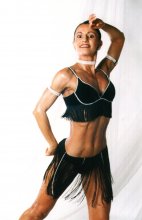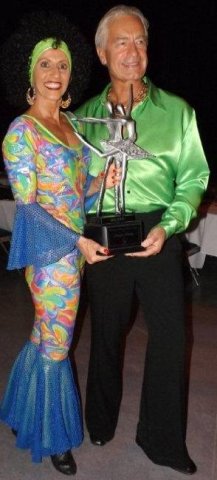You are here
Home ›Rhythm 4 Life

If you’ve got rhythm, who could ask for anything more! Did you know that all sport has a natural rhythm to it? Champion athletes routinely talk about being "in the flow" or "in the zone". Great sports teams operate best when "in rhythm". Rhythm is the oldest and most natural means to enhance physical performance.
Every player has a natural rhythm, which includes everything from the pace at which they process information and react to it, to the ability to pump themselves up or dial it down a notch emotionally. To feel the force in the execution of athletic talent rather then forcing the feel is natural rhythm fully expressed. For example, Lee Trevino is kinetic energy personified but Ben Hogan was just the opposite--a stoic picture of concentration and determination.
Everyone has Rhythm; there are NO EXCEPTIONS. Being "in rhythm" allows us to flow through life instead of struggling against it. Yet few people are able to tap into the incredible power of their natural rhythm. Why?
Because finding your natural rhythm is a matter of being in touch with yourself mentally, physically and emotionally. This is a process that needs to be nurtured and some need guidance. In most cases expert guidance is needed to acquire the know how of tapping into your natural ability of rhythm.
Our lives overflow with rhythm. How about the rhythm associated with breathing. Listen to your heartbeat and pulse. That’s a natural rhythm.
Rhythm 4 Life Concept is:
1. Timing
Timing is the count. More explicitly relating to athletics, timing involves the temporal coordination of agonistic and antagonistic muscle groups to facilitate even and effective movements by the limbs involved.
2. Tempo
Tempo is the speed, rate or rhythm of activity or movements. Tempo relates to the pace of movement.
3. Balance
Balance is a state of equilibrium or equipoise. Balance is an equal distribution of weight, amount, etc. <img
4. Poise
Poise is conduct, the freedom from affectation or embarrassment. Poise is composure, steadiness of mind under stress serene and a self-controlled state of mind. Poise is a state of calmness and tranquility.
Rhythm may be thought of as all the body parts moving together to create a strong symmetrical body. Most sport is asymmetrical (half athletes) meaning that the athletes does not engage the full body equally. For example, in baseball, soccer, tennis, hockey, basketball, Ping-Pong and bowling the athlete favors one limb over the other. Even guitar players have one side that is off center.
Over a period of time, say 2 or 3 years of participating in most sports, the side of the body that is not being used with equal measure will not be developed to it’s fullest potential or utilize all the muscle groups that condition the muscle fibers and nervous system associated with use. Both repetitive overuse and under use can lead to unevenness, imbalance and injury risk to the athlete.
Learning to dance is the absolute best way to learn rhythm. Dance will open the gateways to appreciating the art and science of the 4 steps to rhythm which in turn will enhance athletic performance in any sport you choose.
 Everyone has a natural rhythm and when you learn to recognize this you will then be able to feel the force rather than force the feel. This creates a position of leverage and power in your body motion. It also creates more self-confidence.
Everyone has a natural rhythm and when you learn to recognize this you will then be able to feel the force rather than force the feel. This creates a position of leverage and power in your body motion. It also creates more self-confidence.
One of the keys to finding your natural rhythm is to prepare yourself mentally and emotionally for the challenges ahead. With a positive plan in mind and plenty of practical rehearsal will definitely create a sense of relaxation so one can execute the material with precision.
Most beginners don't go out with a plan; therefore, they aren't in rhythm in their starting positions. The result is a nervous, tentative movement that can possibly set the wrong tone. By the time they find that natural feel, if they find it at all, it's often too late.
When learning the 4 steps of Rhythm you will learn to hold your body up straight and be noticed when you walk into a room. You learn how to move your body to the beat of the music either slow or fast with definite grace, balance and poise. Virtually all cultures have a history of rhythm, drums and movement.
When one learns to ballroom dance they not only tone and sculpt the body, they expend calories, elevate self-esteem and relieve stress. Most professional athletes I have met have lost the fun aspect of the sport and taken a turn towards profit only.
When an athlete is competing in a sport it can become mundane and can result in a loss of a creative outlet of expression. Everyone needs a creative outlet of expression! Dance will keep you on your game. It will offer an outlet that challenges you to activate parts of the brain that have been neglected over the years. It will introduce you to like minded individuals, who, like yourself are seeking to better themselves and move their bodies in a fun filled environment with no judgment or ridicule.
 Another important aspect of ballroom dance is learning to use a full length mirror. Most sports don’t use a mirror; however, the mirror is a great teacher. You will become aware of your own physical presence.
Another important aspect of ballroom dance is learning to use a full length mirror. Most sports don’t use a mirror; however, the mirror is a great teacher. You will become aware of your own physical presence.
In many sports it doesn’t matter what you look like; it’s how you play the game. Physical appearance is important in dance. It doesn’t mean that you have to be in top physical shape or have a wardrobe filled with designer clothing. It means that you will be in close contact with other individuals so proper hygiene, proper conduct and proper clothing is a definite mandate.
For many participants, ballroom dancing is a hobby that provides a pleasant means of obtaining healthy physical activity in a non-smoking, non-alcoholic environment. The heart and lungs receive aerobic stimulation which improves stamina and endurance. The back muscles become stronger, and the legs, ankles and feet adapt with improved condition. On a mental level, one must memorize dance patterns, coordinate body movement with musical rhythm and learn intricate leads & follows. In general, this activity is a full-body toner and creates a positive mental attitude.

It has been said that dancing reflects life itself. A successful dance is made up of lots and lots of little steps that come together according to a plan. This is called choreography. Steps have to be learned and practiced, practiced and practiced because practice not only makes permanent, it makes possible. We then have to harmonize the steps to include a piece of apparatus such as a golf club, bat, javelin, discus, hammer throw, hockey stick, etc…
On a personal level I have worked with many athletes and have observed definite improvement in their respective sport after they have taken structured ballroom dance classes. See you on the dance floor!

Every Day's a Holly Day!
TKH
- Log in to post comments